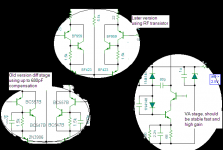As I was driving to work I remembered another commercial amplifier that used this type of Vas The Armstrong 600 series
If you Google Armstrong the home of high fidelity you will find there schematics
regards Trevor
If you Google Armstrong the home of high fidelity you will find there schematics
regards Trevor
Hi,
I like Self for the technical solutions to achieve examplary technical performance.
I do not like his absolute reliance on low distortion to exclusion of all else. Sound quality is important to most of us and he completely avoids that.
I think the Miller compensation capacitor is an example of where he aims for low distortion and automatically gets bad sound performance on varying and multi frequency signals. I also believe that the mirror loaded LTP causes a similar problem but to a lesser extent. But both these need to be examined in detail for the importance of each to the overall performance. Self is the only writer I have seen that is prepared to release all his research data showing why and how to minimise the errors. Use his techniques but be selective.
Technically superb and all the data to back it up.
QFT.
BTW for those who read the old edition of his SS book, the 5th edition is two steps up in the direction of more objectivity.
My favorite is the Darlington Cascode that I used in my MOSFET power amplifier with EC in 1984, published in JAES (available at Cordell Audio: Home Page). The use of the term Darlington is a bit liberal as most think of a Darlington as a transistor pair where both collectors are tied together. The one I use has the collector of the first transistor connected to a power supply (this is what Self has dubbed beta-enhanced). The former will work, but does not provide the benefit of the isolation from Ccb of the main VAS transistor. Although the Darlington itself reduces the nonlinearity due to Early effect in the main VAS transistor by feeding it with a low impedance, the cascode further reduces nonlinearity due to Early effect.
Cheers,
Bob
Cheers,
Bob
QFT.
BTW for those who read the old edition of his SS book, the 5th edition is two steps up in the direction of more objectivity.
Do you mean to say that he has gone more in the direction of depending on only lab measurements, or do you mean an improvement of some kind of objectivity?
Thanks,
Bob
Do you mean to say that he has gone more in the direction of depending on only lab measurements, or do you mean an improvement of some kind of objectivity?
Thanks,
Bob
I mean in the direction of lab testing things that before he just negated (like capacitor distortion, magnetic connectors and so on).
The general style seemed to me less closed minded.
I mean in the direction of lab testing things that before he just negated (like capacitor distortion, magnetic connectors and so on).
The general style seemed to me less closed minded.
Yes, he has been more open-minded and less dismissive of things. He used to poo-poo DC servos for example. In the past he did not mention the Locanthi T circuit Triple, although he still does not properly reference Bart.
He used to dismiss memory distortion, but he now does a better job of recognizing that crossover distortion is a function of time and thermals.
He still dismisses MOSFETs and loves CFP output stages.
Cheers,
Bob
He still dismisses MOSFETs and loves CFP output stages.
Interesting choices. Never could make a repeatable, stable CFP in Class AB without a lot of bothersome b/c caps, which ruin the sound quality.....
I do think it's important to give credit. Not many mention Harry C. Lin, but he did great work back in the fifties and sixties, along with Arthur Bailey.
Hugh
Beta Enhanced emitter follower in VAS??
VAS stage need high performance stable and high gain configuration. I am totally not agree this local feedback applied to VAS stage.
I am using it for input stage and found some disadvantage, I replace different transistor from BF959, SS9018I and 2SC3355, but the last configuration is 2SA872+SS9018, and planning to change it into normal differential.
VAS stage need high performance stable and high gain configuration. I am totally not agree this local feedback applied to VAS stage.
I am using it for input stage and found some disadvantage, I replace different transistor from BF959, SS9018I and 2SC3355, but the last configuration is 2SA872+SS9018, and planning to change it into normal differential.
Attachments
Last edited:
- Status
- Not open for further replies.
- Home
- Amplifiers
- Solid State
- Has anyone ever tried a Beta Enhanced emitter follower VAS??
